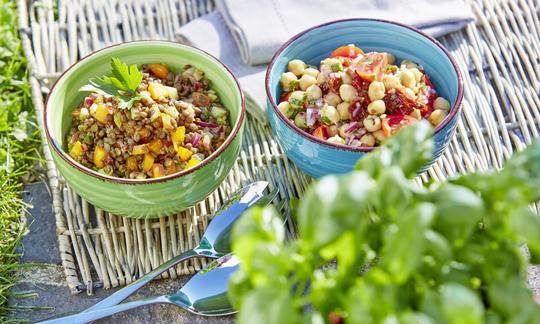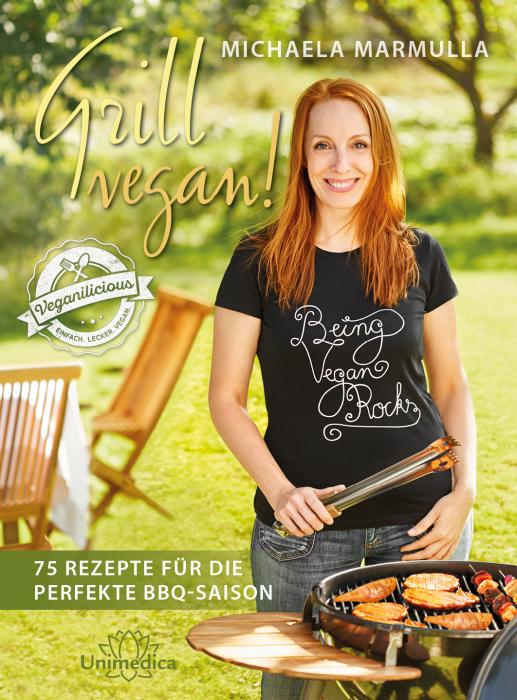Colorful lentil salad with cucumber and olives
vegan
Ingredients (for servings, )
| For the lentil salad | |
|---|---|
| 12 oz | Lentils (Erve, kitchen lentil), raw |
| 1 | Sweet pepper, yellow, raw (organic?) (5.5 oz) |
| 1 | Onions, red (raw, organic?) (2.8 oz) |
| ½ | Cucumbers, peeled, raw (organic?) (8.1 oz) |
| 1 ⅞ oz | Olives, green, pitted, raw (organic?) |
| For the dressing | |
| 2 tbsp | Balsamic vinegar (Aceto balsamico, raw?, organic?) (1.1 oz) |
| 2 tbsp | Lemon juice (raw?, organic?) (0.51 oz) |
| 1 tbsp | Agave syrup (agave syrup, raw?, organic?) (0.41 oz) |
| 25 ml | Olive oil (cold pressed, raw?, organic?) (0.80 oz) |
| 25 ml | Rapeseed oil (canola, HOLL oil, kernel oil), cold pressed?, organic? (0.81 oz) |
| ¼ tsp, whole | Cumin, seeds (raw, organic?) |
| ¼ tsp | Paprika powder, hot (raw?, organic?) (0.02 oz) |
| 1 dash | Table salt (table salt, raw?, organic?) (0.01 oz) |
| 1 dash | Black pepper (organic?, raw?) (0.00 oz) |
| For garnishing | |
| ½ bunch | Parsley, fresh, raw (leaf parsley, parsley) (0.53 oz) |
Equipment
- mortar
- vegetable peeler
- refrigerator
- citrus juicer (lemon squeezer)
- saucepan
Type of preparation
- cook
- chop or grind
- squeeze
- meld
- season to taste
- remove the skin
- peel
Preparation
For the lentil salad
Cook the lentils according to the instructions on the packet until al dente and allow to cool.In the original recipe, the author uses brown-green Puy lentils.
Finely dice the pepper. Peel the onion and cucumber, then finely chop the onion and cut the cucumber into small cubes. Pit and chop the olives. Put everything in a bowl.
The author uses orange peppers in the original recipe, but these can easily be replaced with yellow or red peppers. You can either buy the olives pitted or pit them yourself.
For the dressing
Mix together the balsamic vinegar, lemon juice, agave syrup and oil. Grind the cumin and add it together with the other spices and season well to taste.At this point, Michaela Marmulla uses white balsamic vinegar. This has the typical taste of balsamic vinegar, but does not color the salad dark and is therefore more visually appealing for this recipe.
We used 25 ml olive oil and 25 ml rapeseed oil instead of 50 ml olive oil for 6 people so that this recipe has a healthier ratio of essential fatty acids.
Add the dressing to the lentil salad and leave to sit in the fridge for at least 1 hour.
For garnishing
Before serving the colorful lentil salad, add the chopped parsley and stir briefly.
|
Nutritional Information per person
Convert per 100g
|
2000 kcal | |
|---|---|---|
| Energy | 315 kcal | 15.8% |
| Fat/Lipids | 9.6 g | 13.7% |
| Saturated Fats | 1.1 g | 5.5% |
| Carbohydrates (inc.dietary fiber) | 44 g | 16.4% |
| Sugars | 4.5 g | 5.0% |
| Fiber | 7.5 g | 30.1% |
| Protein/Albumin | 15 g | 30.5% |
| Cooking Salt (Na:34.6 mg) | 88 mg | 3.7% |
| Essential micronutrients with the highest proportions | per person | 2000 kcal | |
|---|---|---|---|
| Vit | Vitamin B9, B11 (Folate, as the active form of folic acid) | 304 µg | 152.0% |
| Vit | Vitamin C (ascorbic acid) | 57 mg | 72.0% |
| Prot | Threonine (Thr, T, irreversibly transaminated) | 0.54 g | 58.0% |
| Prot | Tryptophan (Trp, W) | 0.14 g | 56.0% |
| Prot | Lysine (Lys, K, irreversibly transaminated) | 1.0 g | 56.0% |
| Min | Copper, Cu | 0.53 mg | 53.0% |
| Prot | Isoleucine (Ile, I) | 0.65 g | 52.0% |
| Vit | Vitamin B1 (Thiamine) | 0.54 mg | 49.0% |
| Prot | Phenylalanine (Phe, F) | 0.74 g | 48.0% |
| Min | Manganese, Mn | 0.91 mg | 46.0% |
Detailed Nutritional Information per Person for this Recipe
The majority of the nutritional information comes from the USDA (US Department of Agriculture). This means that the information for natural products is often incomplete or only given within broader categories, whereas in most cases products made from these have more complete information displayed.
If we take flaxseed, for example, the important essential amino acid ALA (omega-3) is only included in an overarching category whereas for flaxseed oil ALA is listed specifically. In time, we will be able to change this, but it will require a lot of work. An “i” appears behind ingredients that have been adjusted and an explanation appears when you hover over this symbol.
For Erb Muesli, the original calculations resulted in 48 % of the daily requirement of ALA — but with the correction, we see that the muesli actually covers >100 % of the necessary recommendation for the omega-3 fatty acid ALA. Our goal is to eventually be able to compare the nutritional value of our recipes with those that are used in conventional western lifestyles.
| Essential fatty acids | per person | 2000 kcal |
|---|---|---|
| Alpha-Linolenic acid; ALA; 18:3 omega-3 | 0.46 g | 23.0% |
| Linoleic acid; LA; 18:2 omega-6 | 1.4 g | 14.0% |
| Essential amino acids | per person | 2000 kcal |
|---|---|---|
| Threonine (Thr, T, irreversibly transaminated) | 0.54 g | 58.0% |
| Tryptophan (Trp, W) | 0.14 g | 56.0% |
| Lysine (Lys, K, irreversibly transaminated) | 1.0 g | 56.0% |
| Isoleucine (Ile, I) | 0.65 g | 52.0% |
| Phenylalanine (Phe, F) | 0.74 g | 48.0% |
| Valin (Val, V) | 0.74 g | 46.0% |
| Leucine (Leu, L) | 1.1 g | 45.0% |
| Methionine (Met, M) | 0.13 g | 14.0% |
| Vitamins | per person | 2000 kcal |
|---|---|---|
| Vitamin B9, B11 (Folate, as the active form of folic acid) | 304 µg | 152.0% |
| Vitamin C (ascorbic acid) | 57 mg | 72.0% |
| Vitamin B1 (Thiamine) | 0.54 mg | 49.0% |
| Vitamin K | 23 µg | 30.0% |
| Vitamin B6 (pyridoxine) | 0.41 mg | 29.0% |
| Vitamin B5 (Pantothenic acid) | 1.4 mg | 24.0% |
| Vitamin E, as a-TEs | 1.6 mg | 14.0% |
| Vitamin B3 (Niacin) | 1.9 mg | 12.0% |
| Vitamin B7 (Biotin, ex vitamin H) | 5.8 µg | 12.0% |
| Vitamin B2 (Riboflavin) | 0.16 mg | 11.0% |
| Vitamin A, as RAE | 44 µg | 6.0% |
| Essential macroelements (macronutrients) | per person | 2000 kcal |
|---|---|---|
| Potassium, K | 553 mg | 28.0% |
| Phosphorus, P | 187 mg | 27.0% |
| Magnesium, Mg | 41 mg | 11.0% |
| Calcium, Ca | 44 mg | 5.0% |
| Sodium, Na | 35 mg | 4.0% |
| Essential trace elements (micronutrients) | per person | 2000 kcal |
|---|---|---|
| Copper, Cu | 0.53 mg | 53.0% |
| Manganese, Mn | 0.91 mg | 46.0% |
| Iron, Fe | 4.5 mg | 32.0% |
| Zinc, Zn | 2.1 mg | 21.0% |
| Selenium, Se | 0.29 µg | 1.0% |
| Fluorine, F | 3.4 µg | < 0.1% |
| Iod, I (Jod, J) | 0.70 µg | < 0.1% |
Narayana Verlag GmbH /Unimedica Verlag , Michaela Marmulla
Raw recipes 28 (1), Cooked recipes 49 (2)
Additional photos (6)
With "Grill Vegan! 75 Recipes for the Perfect BBQ Season," Michaela Marmulla shows how to create many uncomplicated, vegan dishes with just a few ingredients.
Since this book is written in German, a description is omitted here. If you are interested, please switch to German in the menu.
This colorful lentil salad with cucumber, olives and peppers provides you with a delicious taste as well as an extra portion of protein thanks to the matching dressing.
Puy lentils: Puy lentils come from Auvergne. They have a thin green-brown shell, the marbling of which disappears when cooked. Puy lentils have a slightly nutty taste and are a little firmer and less floury than other types of lentils.
White balsamic vinegar: White balsamic vinegar consists essentially of white wine vinegar and light grape must concentrate. In contrast to "Aceto Balsamico Tradizionale di Modena" (not to be confused with the mass-produced "Aceto Balsamico di Modena"), there are no set quality criteria for white balsamic vinegar. Dark vinegar is usually made from blue grapes, although white grapes are used in the case of white vinegar varieties. The white variant, often referred to as "Condimento (Balsamico) bianco", is usually only available in good quality from specialist retailers. Alternatively, you can look in health food stores.
Green/black olives: If you have ever wondered why black olives are up to three times more expensive, this section of text may explain: Olives are naturally relatively bitter and therefore need to be soaked in liquids for a non-strictly defined period of time (usually several weeks) before consumption. Depending on the process, brine or a herbal broth is suitable. Green olives are harvested early and are easy to handle, as differences in quality are hardly noticeable visually. Black olives need to be harvested more carefully and prepared for sale with a stone. As they are fully ripe, the time until harvest is also longer than with green olives.
Spiciness: It is advisable to use rose-hot paprika as a spice, as recommended by the author, as the slight spiciness suits the dish very well.
Pickling olives yourself: Pickling olives is a simple process, but it allows you to use olives that are individually tailored to your taste. In addition, unlike ready-made products, you know exactly what you have on your plate.
Ingredients required: For the washing process you need fresh olives (green, black, mixed), a suitable container (jar, large PET bottle) and plenty of water. For the storage process you need a spice and herb mixture (pepper, rosemary, thyme, chili, garlic, etc.) made to your own taste and a marinade made from oil or salt.
Procedure: Process the olives to make it easier for bitter substances to escape. To do this, you can cut the sides of the olives with a kitchen knife and roll the olives over the work surface with a little pressure. Then put the olives in a container and fill it to the top with water. Change the water daily for the next two weeks if possible.
Storage process: After washing, the storage liquid is prepared. In the case of brine, you need 100-120 grams of sea salt for one liter of water (enough for 1-1.5 kilograms of olives). Boil the brine with the spice and herb mixture, let it cool and put it in a container (e.g. preserving jar) together with the olives. Apply a 1-2 centimeter film of oil as the top layer and store in a cool, dark place. It is important that all the olives are under the surface of the liquid. You can eat the stored olives after around 2 months. The better they are cut/crushed, the quicker the olives will be ready.
Peppers: The orange peppers specified in the original recipe can be replaced with yellow or red peppers, which are easier to obtain.
Onion: If necessary, you can also replace the red onion with a regular yellow onion, although the red onion has a finer taste.




